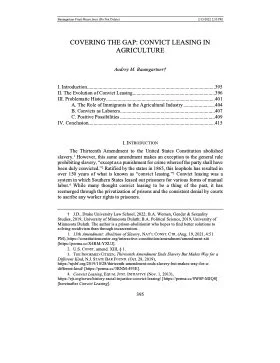COVERING THE GAP: CONVICT LEASING IN AGRICULTURE
By Audrey M. Baumgartner
The Thirteenth Amendment to the United States Constitution abolished slavery.1 However, this same amendment makes an exception to the general rule prohibiting slavery, “except as a punishment for crime whereof the party shall have been duly convicted.”2 Ratified by the states in 1865, this loophole has resulted in over 150 years of what is known as “convict leasing.”3 Convict leasing was a system in which Southern States leased out prisoners for various forms of manual labor.4 While many thought convict leasing to be a thing of the past, it has reemerged through the privatization of prisons and the consistent denial by courts to ascribe any worker rights to prisoners. Flaws in the institutions that provide agricultural labor have resulted in large amounts of produce left unpicked, increased costs for consumers, and decreased investment in agricultural industries.5 Instead of solving problems plaguing the immigration system or fixing flawed worker protection laws for agricultural laborers, convicts are being used to cover these labor shortages. This Note will first walk through the evolution of convict leasing followed by a discussion of the United States prison system’s problematic history. Next, this Note will address the role immigrants play in the American agricultural industry. Lastly, this Note will focus on convicts as laborers; specifically, the positives and negatives associated with using incarcerated individuals to cover the agricultural labor shortage in the United States. This Note’s ultimate conclusion follows that convict leasing in agriculture can be a rehabilitative and positive solution to the labor shortage so long as inmates are treated with the same respect as other workers in these industries.
Duke Journal of Agricultural Law, 26(3): 2022


